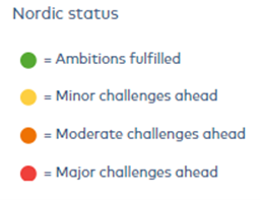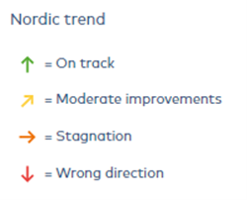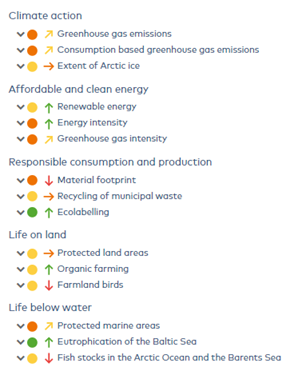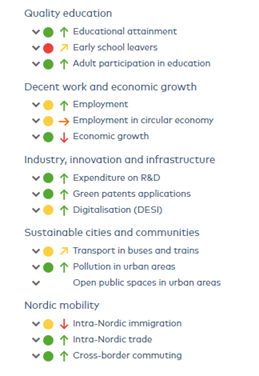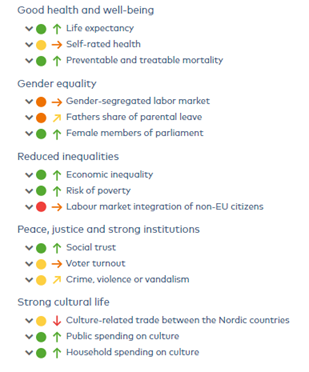Our Vision 2030 – status and trends of the Nordic indicators
When the United Nations launched their 2030 Sustainable Development Agenda in 2015, Secretary-General Ban Ki-moon emphasized that “reliable and timely statistics and indicators are more important than ever” [1]. In the light of this and on this World Statistics Day [2] we will present and go through status and trends for the Nordic indicators of Our Vision 2030 [3].
Our Vision 2030
Our Vision 2030 is the vision for the Nordic Co-operation and was adopted by the Nordic Prime Ministers in 2019. In short, it states that the Nordic Region will become the most sustainable and integrated region in the world by 2030. Three areas are prioritized in the period up to 2024:
– A green Nordic Region, promoting a green transition of our societies and working towards carbon neutrality and a sustainable circular and bio-based economy.
– A competitive Nordic Region, promoting green growth in the Nordic Region based on knowledge, innovation, mobility and digital integration.
– A socially sustainable Nordic Region, promoting an inclusive, equal and interconnected region with shared values and strengthened cultural exchange and welfare.
Nordic Indicators
To evaluate the progress towards the vision goals, the Prime Ministers for the Nordic Co-operation adopted a set of Nordic indicators in September 2020. There is a total of 45 Nordic indicators linked to the vision's three prioritized areas. Each area has five sub-areas, and each of those has three associated indicators.
On the Nordic Statistics web page an overview of the Nordic indicators can be found (link given below). Next to the indicator name is a circle and an arrow. The colour of the circles shows the status of the indicator today. The direction and colour of the arrows on the other hand indicates the prognostic moving direction, the trend, indicating if the target is about to be met given the development up until this point.
In 2021 a baseline report was written, establishing the status of the Nordic region and presenting the Nordic indicators and their starting point [4]. In June this year a follow-up analysis of the status and the trends of the Nordic indicators was performed, based on indicator values for 2021, with the aim of evaluating the progress towards the goal of fulfilling the vision. This evaluation is presented in a status report [5].
Status?
The status report from 2023 shows that, overall, the Nordic region is still on track to becoming the most sustainable and integrated region in the world. This particularly applies to the visions of a competitive and socially sustainable Nordic region, whereas there is still room for improvement for the vision of a green Nordic region to be fulfilled.
A Green Nordic region
The status report from 2023 points out that the Nordic region faces significant challenges in several areas when it comes to realizing the ambitions of a green Nordic region, both now and in the future towards 2030.
Even though the development is generally going in the right direction, there are several indicators where the pace is too slow if the ambitions for Our Vision 2030 are to be realised. For six indicators, the development trend seems to stagnate or even go in the wrong direction towards 2030. On the positive side, there is progress for several indicators compared to the baseline report 2021: Specifically, the status of three indicators (Energy intensity, Eutrophication of the Baltic Sea and Ecolabelling) has changed in a positive direction, while two (Recycling of municipal waste and Farmland birds) has moved in a negative direction. The figure below shows the status and prognostic trends for the green Nordic indicators.
A competitive Nordic region
The status report from 2023 indicates that the Nordic region is on the right track in terms of fulfilling the ambition of a competitive Nordic region in 2030, which is based on green growth, innovation, mobility and a circular economy. If the current development continues, the Nordic region will move towards becoming an even more competitive region in 2030. Since the baseline report 2021, there has been progress in the status picture for economic growth, while both employment and school dropout rates have moved in a negative direction. The figure below shows the status and prognostic trends for the competitive Nordic indicators.
A socially sustainable Nordic region
The status report from 2023 shows that the Nordic region is generally well on its way to realizing the ambitions of a socially sustainable region. The Nordic region is characterized by good health, high employment, as well as high trust and low crime.
However, the Nordic countries still have room for improvement, especially in terms of gender equality, integration of non-EU citizens in the labour market and self-assessed well-being. Since the baseline report, the status picture of this strategic priority has not changed enough for the status of any indicator to change colour. The figure below shows the status and the and prognostic trends for the socially sustainable Nordic indicators.
On the Nordic Statistics web page, https://indicators.nordicstatistics.org/ourvision2030, an overview of the Nordic indicators and links to the baseline and status reports can be found. Also, the Nordic indicator data can be found here.
_________________________________________________________________________________
[2] Even though the United Nations only observe World Statistics Day every fifth year, we take the opportunity of observing it every year as statistics is an important part of evaluating initiatives targeting development goals.
[3] https://www.norden.org/en/declaration/our-vision-2030
